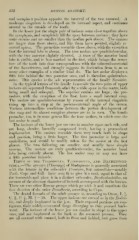Page 422 - My FlipBook
P. 422
432 DENTAL ANAT03IY.
and occupies a position opposite the interval of the two external. A
moderate cingulum is developed on its internal aspect, and continues
around to the outside of the tooth.
In the lower jaw the single pair of incisors come close together above
the symphysis, and completely fill the space between canines ; they have
conic crowns and are smaller than the median pair above. The canines
are larger than those above, and like them have pointed, slightly re-
curved apices. The premolars resemble those above, with the exception
that the internal lobe is absent. The true molars are quadritubercular,
with the two anterior slightly elevated. A trace of the anterior basal
lobe is visible, and is best marked in the first, ^^^hich brings the struc-
ture of the tooth into close correspondence with the tuberculo-sectorial
of the Insectivores, and strongly suggests its derivation from it, as so
many other examples of a similar kind do. The last molar displays a
fifth lobe behind the two posterior ones, and is therefore quintituber-
cular. This species is the sole representative of the family Tarsiidce.
In the typical lemurs of the family Lemuridce the two pairs of upper
incisors are separated from each other by a wide space in the centre, both
being small and subequal. The superior canines are large ; the pre-
molars, with the exception of the first, have a small internal cusp.
The molars are quadritubercular by reason of the internal cingulum
rising up into a cusp at the postero-external angle of the crown.
Various intermediate conditions betMcen the perfect development of
this cusp and its almost complete absence are to be seen. The fourth
premolar, too, is in some genera like the true molars, in which case the
last molar is small.
The incisors of the lower jaw are two in number upon each side, and
are long, slender, laterally compressed teeth, having a procumbent
implantation. The canines resemble them very much both in shape
and position, being a little larger. The first premolar is large and
caniniform, and would be readily taken for the canine at the first
glance. The two following are smaller, and usually have simple
crowns. The molars are truly quadritubercular, the anterior basal
lobe being entirely absent. The last molar may or may not have
a fifth posterior tubercle.
Teeth of the Tillodoxta, Tvexiodoxta, and Daubentoni-
oiDEA.—The aye-aye (Chiromys) of Madagascar is generally associated
with the lemurs in the sub-order Prot^imicc, but naturalists—notably
Profs. Cope and Gill—have seen fit to give it a rank equal to that of
the lemuroids and j^lace it in a distinct sub-order, Dmtbcntonioidea, on
account of the aberrant character of its teeth as compared with the lemurs.
There are two other Eocene groups which go ^vith it and constitute the
first division of the order Buuotheria, according to Cope.
The dental formula of the adult aye-aye is, according to Owen, I. ]-,
C. P. \, M. f = 18. The upper incisors are curved as in the Roden-
I",
tin, and deejily implanted in the jaw. Their exposed portions are con-
tiguous, their widely-excavated fangs diverging as they proceed back-
ward. The incisors of the lower jaw are similar in shape to the upper
ones, and are implanted as far back as the coronoid process. They
are all covered with enamel, both in front and behind, and grow from


